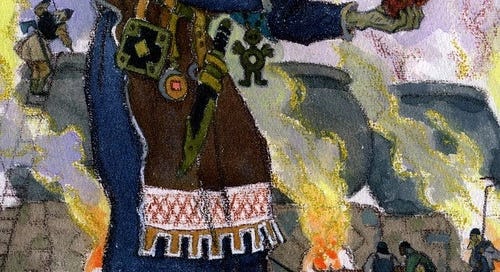This is part of a collaboration with Laura B where different parts of folklore will get a different focus from writers with different backgrounds and different locations.
The first theme is “The Hag”.
I chose to writa about Louhi, the Hag queen in Kalevala, but realized that I had to introduce Kalevala first.
So this post is a colletion of 4 posts.
First an introduction to Kalevala.
Kalevala is the national epic of Finland. It was compiled by Elias Lönnrot based to poems he and his helpers collected from various areas, mainly in Eastern Finland, Karelia and Ingria. The first version of Kalevala was published in 1835 (The Old Kalevala), but the version most commonly known today was first published in 1849 (The New Kalevala).
Kalevala starts with a creation myth, where the world hatched from a common goldeneye's egg. Kalevala tells various stories, including some about the people of Kalevala and Pohjola and the building and stealing of Sampo. The events end with the arrival of Christianity.
Kalevala had an important role in the development of the Finnish national identity. It has also affected Finnish culture and art.
Kalevala- Songs from the Far North
In the northern forests of Finland, where the lakes reflect the sky and pine trees murmur ancient secrets, a great poem was born. The Kalevala, Finland's national epic, is a tapestry of myth, magic, and memory—an oral tradition stitched together by Elias Lönnrot in the 19th century. To read the
Now it’s time to introduce Louhi (other names Loviatar, Loveatar, Lovetar, Lovehetar, Louhetar, Louhiatar) is a sorceress (noita) and the ruler of Pohjola. She is described as mean, gap-toothed and strong nosed.
Louhi has strong magical powers, and she is able to shapeshift, change the weather and the movements of the sun and the moon, heal and give birth to weird creatures and monsters. She was feared and respected for her skills. Also known as the Mistress of Pohjola, Louhi is also seen as a resolute and intelligent leader of her community.
Tolkien got a lot of inspiration from Kalevala. He learnt finnish to be able to read it.
Tolkien and the Kalevala: A Northern Light in Middle-earth
A Spark from Finland: Tolkien Discovers the Kalevala
And finaly a post about the painting with the Lapland witches.
Milton’s Night-Hag and Fuseli’s Vision of Lapland Witches
In Henry Fuseli’s oil painting The Night-Hag Visiting Lapland Witches (c. 1796), a wild nocturnal ritual springs to life – witches whirl in frenzy, a demoness hurtles through the moonlit sky, and a child lies eerily tranquil on a sacrificial altar. Fuseli drew his inspiration directly from a brief but vivid simile in John Milton’s epic






